Leadership and Management Exam Report - Crisis Leadership & Innovation
VerifiedAdded on 2022/11/29
|12
|3966
|278
Report
AI Summary
This report critically evaluates the challenges and effective styles of leadership in management innovation within the context of digital transformation. It explores various leadership styles, including directive, transformational, servant, and participative leadership, analyzing their strengths, weaknesses, and impact on organizational culture and innovation. The report further examines the role of leadership during crises, specifically the COVID-19 pandemic, highlighting the importance of inspiring action, establishing strong communication, and fostering trust. It discusses how effective leaders can navigate challenges, promote employee engagement, and drive successful outcomes in rapidly changing environments, emphasizing the need for adaptability and strategic vision. The report concludes by underscoring the significance of leadership in shaping organizational culture, driving innovation, and ensuring resilience in times of uncertainty.
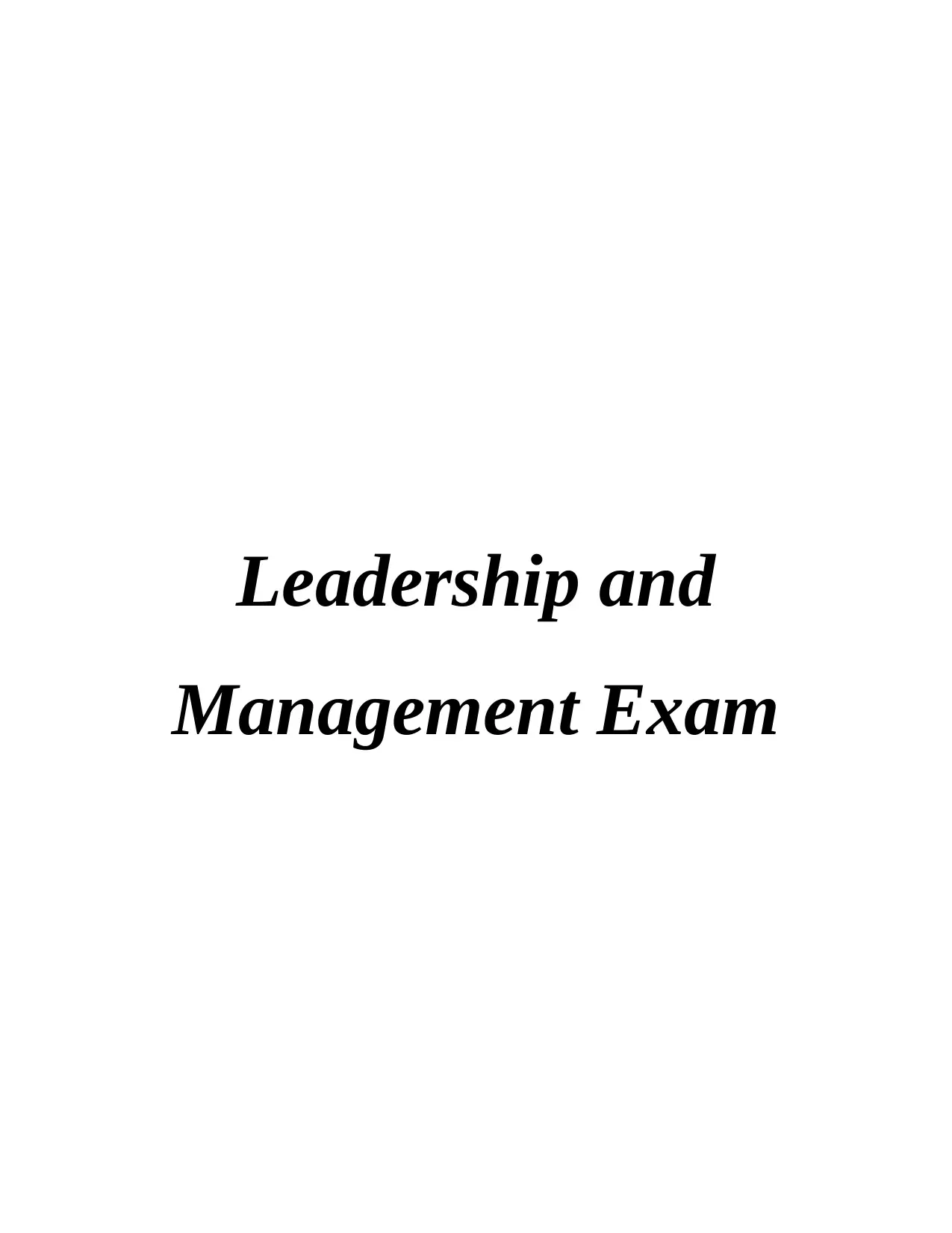
Leadership and
Management Exam
Management Exam
Paraphrase This Document
Need a fresh take? Get an instant paraphrase of this document with our AI Paraphraser
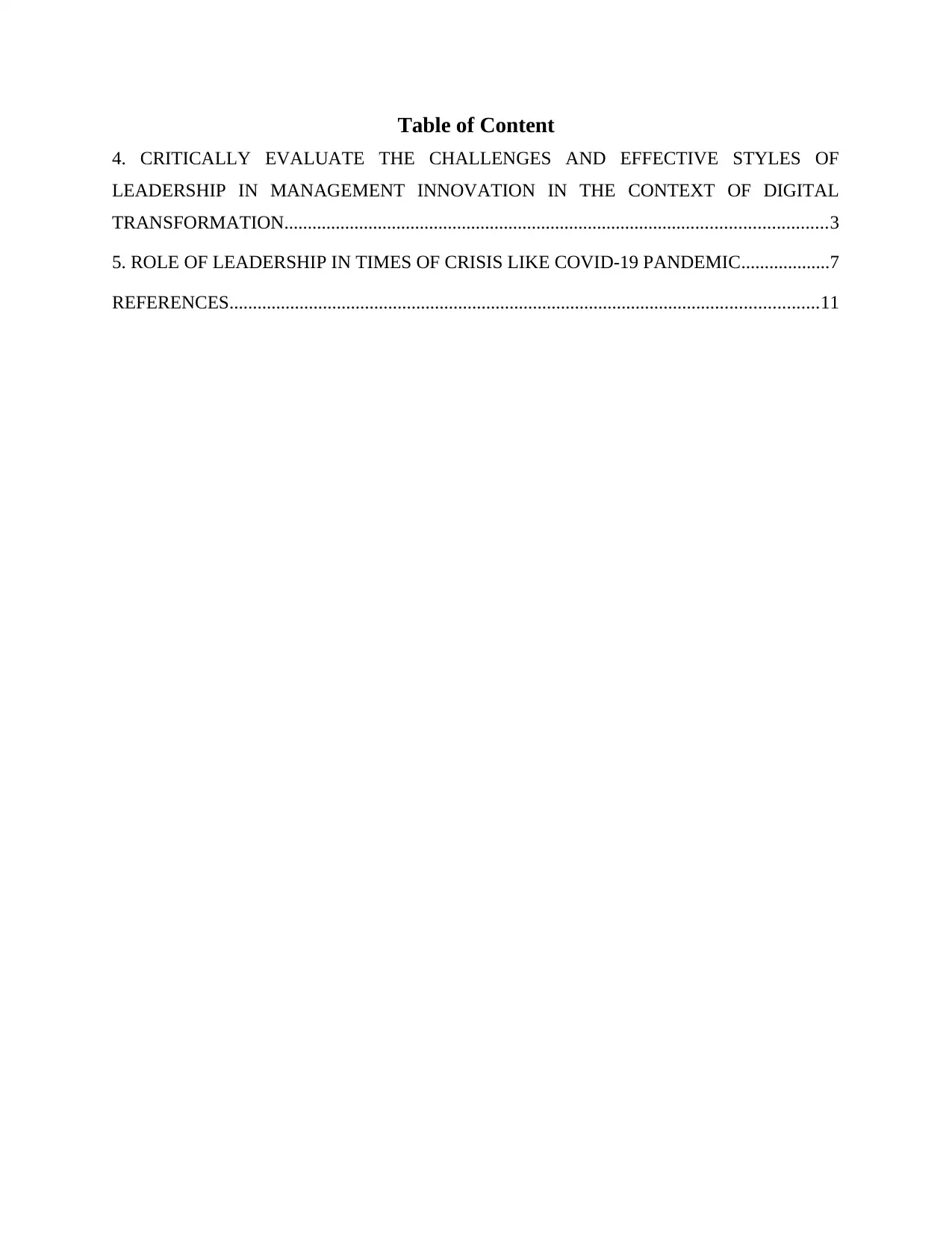
Table of Content
4. CRITICALLY EVALUATE THE CHALLENGES AND EFFECTIVE STYLES OF
LEADERSHIP IN MANAGEMENT INNOVATION IN THE CONTEXT OF DIGITAL
TRANSFORMATION....................................................................................................................3
5. ROLE OF LEADERSHIP IN TIMES OF CRISIS LIKE COVID-19 PANDEMIC...................7
REFERENCES..............................................................................................................................11
4. CRITICALLY EVALUATE THE CHALLENGES AND EFFECTIVE STYLES OF
LEADERSHIP IN MANAGEMENT INNOVATION IN THE CONTEXT OF DIGITAL
TRANSFORMATION....................................................................................................................3
5. ROLE OF LEADERSHIP IN TIMES OF CRISIS LIKE COVID-19 PANDEMIC...................7
REFERENCES..............................................................................................................................11
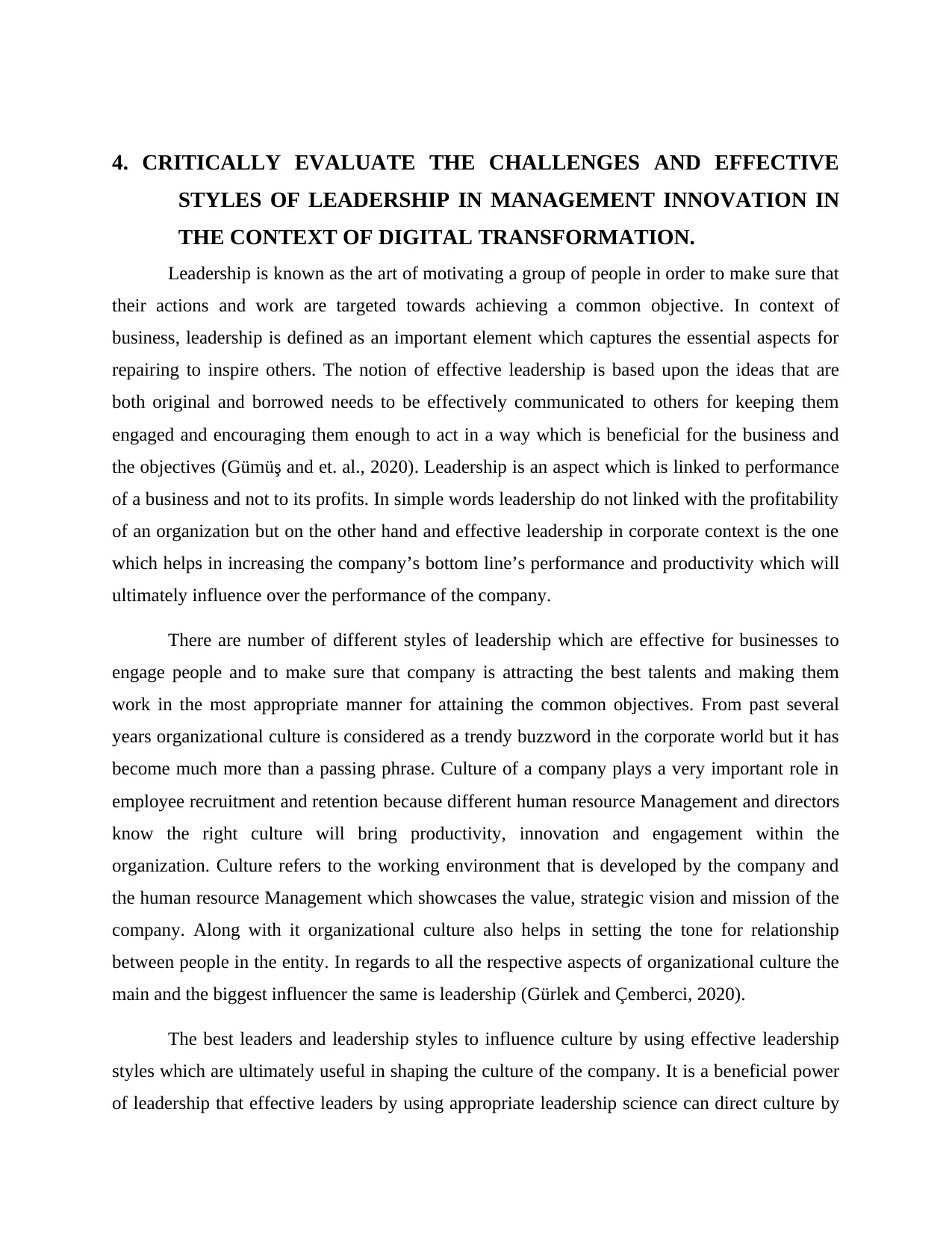
4. CRITICALLY EVALUATE THE CHALLENGES AND EFFECTIVE
STYLES OF LEADERSHIP IN MANAGEMENT INNOVATION IN
THE CONTEXT OF DIGITAL TRANSFORMATION.
Leadership is known as the art of motivating a group of people in order to make sure that
their actions and work are targeted towards achieving a common objective. In context of
business, leadership is defined as an important element which captures the essential aspects for
repairing to inspire others. The notion of effective leadership is based upon the ideas that are
both original and borrowed needs to be effectively communicated to others for keeping them
engaged and encouraging them enough to act in a way which is beneficial for the business and
the objectives (Gümüş and et. al., 2020). Leadership is an aspect which is linked to performance
of a business and not to its profits. In simple words leadership do not linked with the profitability
of an organization but on the other hand and effective leadership in corporate context is the one
which helps in increasing the company’s bottom line’s performance and productivity which will
ultimately influence over the performance of the company.
There are number of different styles of leadership which are effective for businesses to
engage people and to make sure that company is attracting the best talents and making them
work in the most appropriate manner for attaining the common objectives. From past several
years organizational culture is considered as a trendy buzzword in the corporate world but it has
become much more than a passing phrase. Culture of a company plays a very important role in
employee recruitment and retention because different human resource Management and directors
know the right culture will bring productivity, innovation and engagement within the
organization. Culture refers to the working environment that is developed by the company and
the human resource Management which showcases the value, strategic vision and mission of the
company. Along with it organizational culture also helps in setting the tone for relationship
between people in the entity. In regards to all the respective aspects of organizational culture the
main and the biggest influencer the same is leadership (Gürlek and Çemberci, 2020).
The best leaders and leadership styles to influence culture by using effective leadership
styles which are ultimately useful in shaping the culture of the company. It is a beneficial power
of leadership that effective leaders by using appropriate leadership science can direct culture by
STYLES OF LEADERSHIP IN MANAGEMENT INNOVATION IN
THE CONTEXT OF DIGITAL TRANSFORMATION.
Leadership is known as the art of motivating a group of people in order to make sure that
their actions and work are targeted towards achieving a common objective. In context of
business, leadership is defined as an important element which captures the essential aspects for
repairing to inspire others. The notion of effective leadership is based upon the ideas that are
both original and borrowed needs to be effectively communicated to others for keeping them
engaged and encouraging them enough to act in a way which is beneficial for the business and
the objectives (Gümüş and et. al., 2020). Leadership is an aspect which is linked to performance
of a business and not to its profits. In simple words leadership do not linked with the profitability
of an organization but on the other hand and effective leadership in corporate context is the one
which helps in increasing the company’s bottom line’s performance and productivity which will
ultimately influence over the performance of the company.
There are number of different styles of leadership which are effective for businesses to
engage people and to make sure that company is attracting the best talents and making them
work in the most appropriate manner for attaining the common objectives. From past several
years organizational culture is considered as a trendy buzzword in the corporate world but it has
become much more than a passing phrase. Culture of a company plays a very important role in
employee recruitment and retention because different human resource Management and directors
know the right culture will bring productivity, innovation and engagement within the
organization. Culture refers to the working environment that is developed by the company and
the human resource Management which showcases the value, strategic vision and mission of the
company. Along with it organizational culture also helps in setting the tone for relationship
between people in the entity. In regards to all the respective aspects of organizational culture the
main and the biggest influencer the same is leadership (Gürlek and Çemberci, 2020).
The best leaders and leadership styles to influence culture by using effective leadership
styles which are ultimately useful in shaping the culture of the company. It is a beneficial power
of leadership that effective leaders by using appropriate leadership science can direct culture by
⊘ This is a preview!⊘
Do you want full access?
Subscribe today to unlock all pages.

Trusted by 1+ million students worldwide
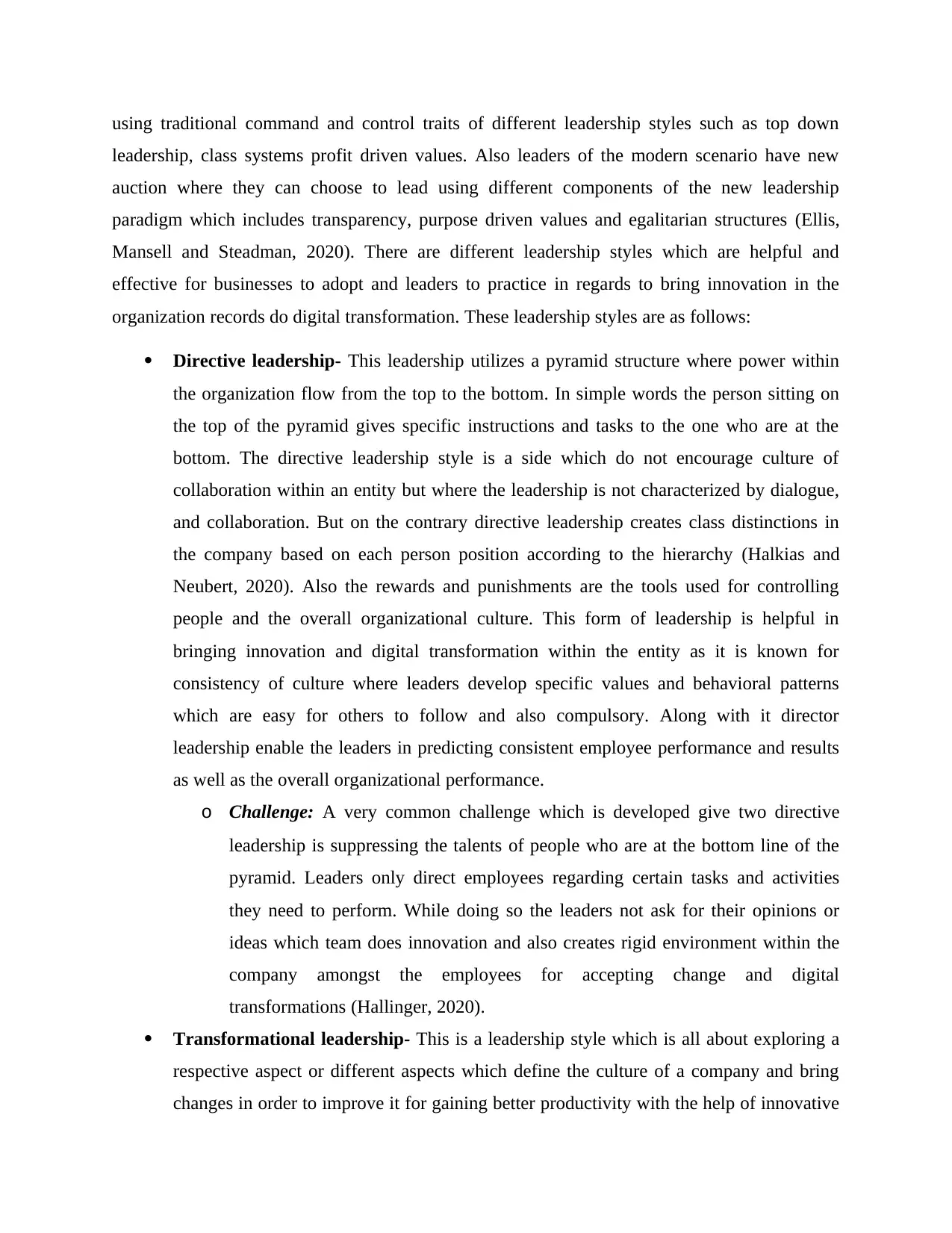
using traditional command and control traits of different leadership styles such as top down
leadership, class systems profit driven values. Also leaders of the modern scenario have new
auction where they can choose to lead using different components of the new leadership
paradigm which includes transparency, purpose driven values and egalitarian structures (Ellis,
Mansell and Steadman, 2020). There are different leadership styles which are helpful and
effective for businesses to adopt and leaders to practice in regards to bring innovation in the
organization records do digital transformation. These leadership styles are as follows:
Directive leadership- This leadership utilizes a pyramid structure where power within
the organization flow from the top to the bottom. In simple words the person sitting on
the top of the pyramid gives specific instructions and tasks to the one who are at the
bottom. The directive leadership style is a side which do not encourage culture of
collaboration within an entity but where the leadership is not characterized by dialogue,
and collaboration. But on the contrary directive leadership creates class distinctions in
the company based on each person position according to the hierarchy (Halkias and
Neubert, 2020). Also the rewards and punishments are the tools used for controlling
people and the overall organizational culture. This form of leadership is helpful in
bringing innovation and digital transformation within the entity as it is known for
consistency of culture where leaders develop specific values and behavioral patterns
which are easy for others to follow and also compulsory. Along with it director
leadership enable the leaders in predicting consistent employee performance and results
as well as the overall organizational performance.
o Challenge: A very common challenge which is developed give two directive
leadership is suppressing the talents of people who are at the bottom line of the
pyramid. Leaders only direct employees regarding certain tasks and activities
they need to perform. While doing so the leaders not ask for their opinions or
ideas which team does innovation and also creates rigid environment within the
company amongst the employees for accepting change and digital
transformations (Hallinger, 2020).
Transformational leadership- This is a leadership style which is all about exploring a
respective aspect or different aspects which define the culture of a company and bring
changes in order to improve it for gaining better productivity with the help of innovative
leadership, class systems profit driven values. Also leaders of the modern scenario have new
auction where they can choose to lead using different components of the new leadership
paradigm which includes transparency, purpose driven values and egalitarian structures (Ellis,
Mansell and Steadman, 2020). There are different leadership styles which are helpful and
effective for businesses to adopt and leaders to practice in regards to bring innovation in the
organization records do digital transformation. These leadership styles are as follows:
Directive leadership- This leadership utilizes a pyramid structure where power within
the organization flow from the top to the bottom. In simple words the person sitting on
the top of the pyramid gives specific instructions and tasks to the one who are at the
bottom. The directive leadership style is a side which do not encourage culture of
collaboration within an entity but where the leadership is not characterized by dialogue,
and collaboration. But on the contrary directive leadership creates class distinctions in
the company based on each person position according to the hierarchy (Halkias and
Neubert, 2020). Also the rewards and punishments are the tools used for controlling
people and the overall organizational culture. This form of leadership is helpful in
bringing innovation and digital transformation within the entity as it is known for
consistency of culture where leaders develop specific values and behavioral patterns
which are easy for others to follow and also compulsory. Along with it director
leadership enable the leaders in predicting consistent employee performance and results
as well as the overall organizational performance.
o Challenge: A very common challenge which is developed give two directive
leadership is suppressing the talents of people who are at the bottom line of the
pyramid. Leaders only direct employees regarding certain tasks and activities
they need to perform. While doing so the leaders not ask for their opinions or
ideas which team does innovation and also creates rigid environment within the
company amongst the employees for accepting change and digital
transformations (Hallinger, 2020).
Transformational leadership- This is a leadership style which is all about exploring a
respective aspect or different aspects which define the culture of a company and bring
changes in order to improve it for gaining better productivity with the help of innovative
Paraphrase This Document
Need a fresh take? Get an instant paraphrase of this document with our AI Paraphraser
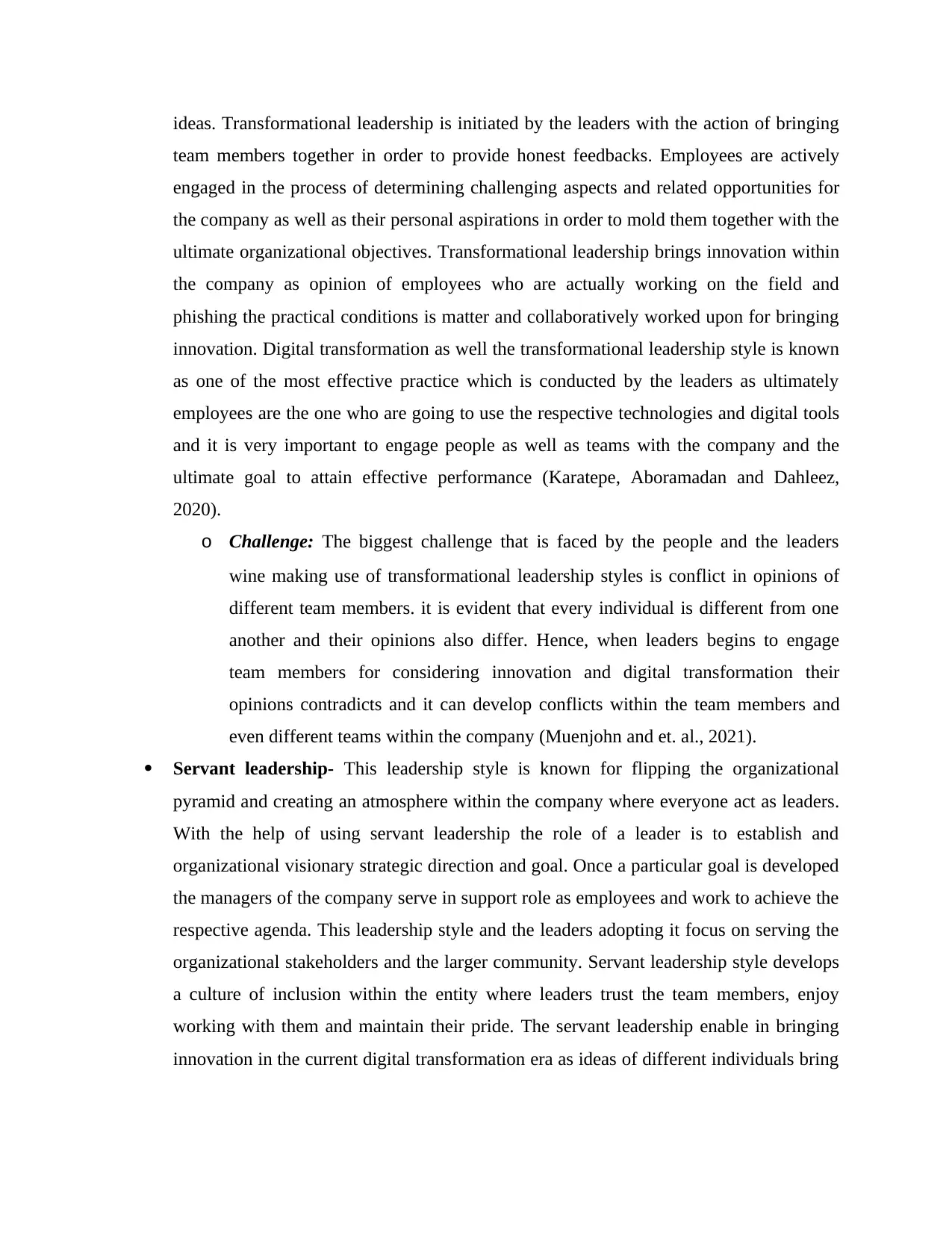
ideas. Transformational leadership is initiated by the leaders with the action of bringing
team members together in order to provide honest feedbacks. Employees are actively
engaged in the process of determining challenging aspects and related opportunities for
the company as well as their personal aspirations in order to mold them together with the
ultimate organizational objectives. Transformational leadership brings innovation within
the company as opinion of employees who are actually working on the field and
phishing the practical conditions is matter and collaboratively worked upon for bringing
innovation. Digital transformation as well the transformational leadership style is known
as one of the most effective practice which is conducted by the leaders as ultimately
employees are the one who are going to use the respective technologies and digital tools
and it is very important to engage people as well as teams with the company and the
ultimate goal to attain effective performance (Karatepe, Aboramadan and Dahleez,
2020).
o Challenge: The biggest challenge that is faced by the people and the leaders
wine making use of transformational leadership styles is conflict in opinions of
different team members. it is evident that every individual is different from one
another and their opinions also differ. Hence, when leaders begins to engage
team members for considering innovation and digital transformation their
opinions contradicts and it can develop conflicts within the team members and
even different teams within the company (Muenjohn and et. al., 2021).
Servant leadership- This leadership style is known for flipping the organizational
pyramid and creating an atmosphere within the company where everyone act as leaders.
With the help of using servant leadership the role of a leader is to establish and
organizational visionary strategic direction and goal. Once a particular goal is developed
the managers of the company serve in support role as employees and work to achieve the
respective agenda. This leadership style and the leaders adopting it focus on serving the
organizational stakeholders and the larger community. Servant leadership style develops
a culture of inclusion within the entity where leaders trust the team members, enjoy
working with them and maintain their pride. The servant leadership enable in bringing
innovation in the current digital transformation era as ideas of different individuals bring
team members together in order to provide honest feedbacks. Employees are actively
engaged in the process of determining challenging aspects and related opportunities for
the company as well as their personal aspirations in order to mold them together with the
ultimate organizational objectives. Transformational leadership brings innovation within
the company as opinion of employees who are actually working on the field and
phishing the practical conditions is matter and collaboratively worked upon for bringing
innovation. Digital transformation as well the transformational leadership style is known
as one of the most effective practice which is conducted by the leaders as ultimately
employees are the one who are going to use the respective technologies and digital tools
and it is very important to engage people as well as teams with the company and the
ultimate goal to attain effective performance (Karatepe, Aboramadan and Dahleez,
2020).
o Challenge: The biggest challenge that is faced by the people and the leaders
wine making use of transformational leadership styles is conflict in opinions of
different team members. it is evident that every individual is different from one
another and their opinions also differ. Hence, when leaders begins to engage
team members for considering innovation and digital transformation their
opinions contradicts and it can develop conflicts within the team members and
even different teams within the company (Muenjohn and et. al., 2021).
Servant leadership- This leadership style is known for flipping the organizational
pyramid and creating an atmosphere within the company where everyone act as leaders.
With the help of using servant leadership the role of a leader is to establish and
organizational visionary strategic direction and goal. Once a particular goal is developed
the managers of the company serve in support role as employees and work to achieve the
respective agenda. This leadership style and the leaders adopting it focus on serving the
organizational stakeholders and the larger community. Servant leadership style develops
a culture of inclusion within the entity where leaders trust the team members, enjoy
working with them and maintain their pride. The servant leadership enable in bringing
innovation in the current digital transformation era as ideas of different individuals bring
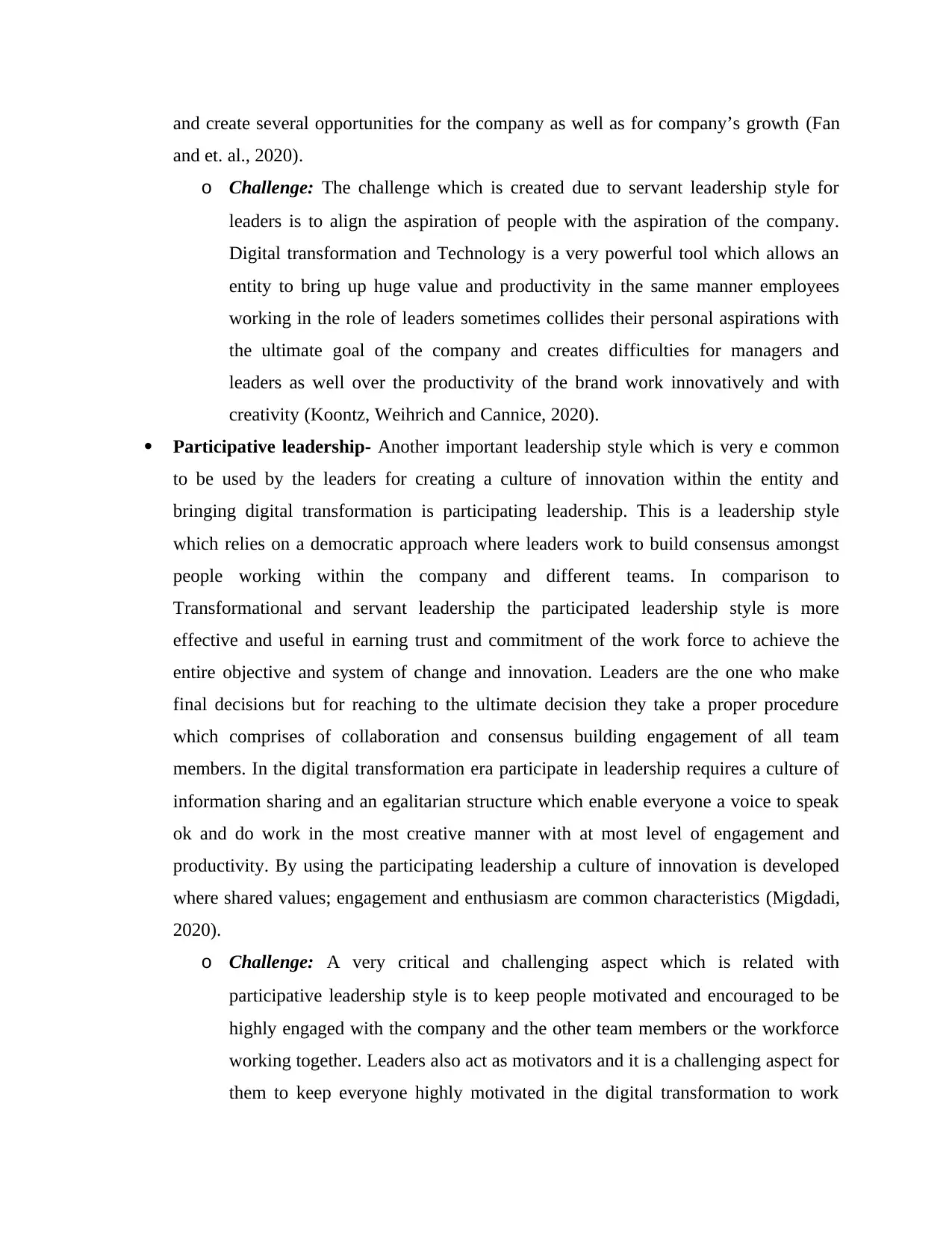
and create several opportunities for the company as well as for company’s growth (Fan
and et. al., 2020).
o Challenge: The challenge which is created due to servant leadership style for
leaders is to align the aspiration of people with the aspiration of the company.
Digital transformation and Technology is a very powerful tool which allows an
entity to bring up huge value and productivity in the same manner employees
working in the role of leaders sometimes collides their personal aspirations with
the ultimate goal of the company and creates difficulties for managers and
leaders as well over the productivity of the brand work innovatively and with
creativity (Koontz, Weihrich and Cannice, 2020).
Participative leadership- Another important leadership style which is very e common
to be used by the leaders for creating a culture of innovation within the entity and
bringing digital transformation is participating leadership. This is a leadership style
which relies on a democratic approach where leaders work to build consensus amongst
people working within the company and different teams. In comparison to
Transformational and servant leadership the participated leadership style is more
effective and useful in earning trust and commitment of the work force to achieve the
entire objective and system of change and innovation. Leaders are the one who make
final decisions but for reaching to the ultimate decision they take a proper procedure
which comprises of collaboration and consensus building engagement of all team
members. In the digital transformation era participate in leadership requires a culture of
information sharing and an egalitarian structure which enable everyone a voice to speak
ok and do work in the most creative manner with at most level of engagement and
productivity. By using the participating leadership a culture of innovation is developed
where shared values; engagement and enthusiasm are common characteristics (Migdadi,
2020).
o Challenge: A very critical and challenging aspect which is related with
participative leadership style is to keep people motivated and encouraged to be
highly engaged with the company and the other team members or the workforce
working together. Leaders also act as motivators and it is a challenging aspect for
them to keep everyone highly motivated in the digital transformation to work
and et. al., 2020).
o Challenge: The challenge which is created due to servant leadership style for
leaders is to align the aspiration of people with the aspiration of the company.
Digital transformation and Technology is a very powerful tool which allows an
entity to bring up huge value and productivity in the same manner employees
working in the role of leaders sometimes collides their personal aspirations with
the ultimate goal of the company and creates difficulties for managers and
leaders as well over the productivity of the brand work innovatively and with
creativity (Koontz, Weihrich and Cannice, 2020).
Participative leadership- Another important leadership style which is very e common
to be used by the leaders for creating a culture of innovation within the entity and
bringing digital transformation is participating leadership. This is a leadership style
which relies on a democratic approach where leaders work to build consensus amongst
people working within the company and different teams. In comparison to
Transformational and servant leadership the participated leadership style is more
effective and useful in earning trust and commitment of the work force to achieve the
entire objective and system of change and innovation. Leaders are the one who make
final decisions but for reaching to the ultimate decision they take a proper procedure
which comprises of collaboration and consensus building engagement of all team
members. In the digital transformation era participate in leadership requires a culture of
information sharing and an egalitarian structure which enable everyone a voice to speak
ok and do work in the most creative manner with at most level of engagement and
productivity. By using the participating leadership a culture of innovation is developed
where shared values; engagement and enthusiasm are common characteristics (Migdadi,
2020).
o Challenge: A very critical and challenging aspect which is related with
participative leadership style is to keep people motivated and encouraged to be
highly engaged with the company and the other team members or the workforce
working together. Leaders also act as motivators and it is a challenging aspect for
them to keep everyone highly motivated in the digital transformation to work
⊘ This is a preview!⊘
Do you want full access?
Subscribe today to unlock all pages.

Trusted by 1+ million students worldwide
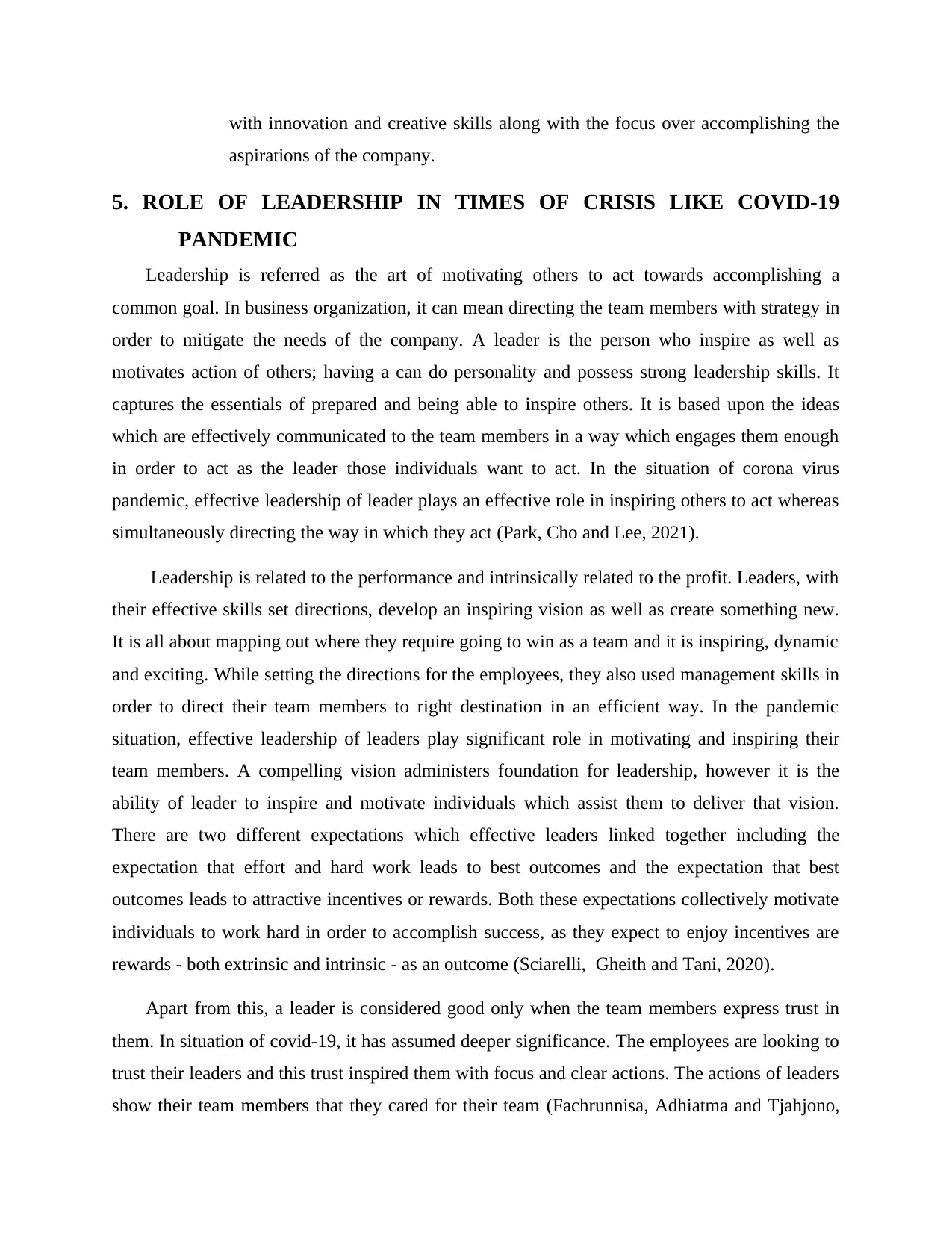
with innovation and creative skills along with the focus over accomplishing the
aspirations of the company.
5. ROLE OF LEADERSHIP IN TIMES OF CRISIS LIKE COVID-19
PANDEMIC
Leadership is referred as the art of motivating others to act towards accomplishing a
common goal. In business organization, it can mean directing the team members with strategy in
order to mitigate the needs of the company. A leader is the person who inspire as well as
motivates action of others; having a can do personality and possess strong leadership skills. It
captures the essentials of prepared and being able to inspire others. It is based upon the ideas
which are effectively communicated to the team members in a way which engages them enough
in order to act as the leader those individuals want to act. In the situation of corona virus
pandemic, effective leadership of leader plays an effective role in inspiring others to act whereas
simultaneously directing the way in which they act (Park, Cho and Lee, 2021).
Leadership is related to the performance and intrinsically related to the profit. Leaders, with
their effective skills set directions, develop an inspiring vision as well as create something new.
It is all about mapping out where they require going to win as a team and it is inspiring, dynamic
and exciting. While setting the directions for the employees, they also used management skills in
order to direct their team members to right destination in an efficient way. In the pandemic
situation, effective leadership of leaders play significant role in motivating and inspiring their
team members. A compelling vision administers foundation for leadership, however it is the
ability of leader to inspire and motivate individuals which assist them to deliver that vision.
There are two different expectations which effective leaders linked together including the
expectation that effort and hard work leads to best outcomes and the expectation that best
outcomes leads to attractive incentives or rewards. Both these expectations collectively motivate
individuals to work hard in order to accomplish success, as they expect to enjoy incentives are
rewards - both extrinsic and intrinsic - as an outcome (Sciarelli, Gheith and Tani, 2020).
Apart from this, a leader is considered good only when the team members express trust in
them. In situation of covid-19, it has assumed deeper significance. The employees are looking to
trust their leaders and this trust inspired them with focus and clear actions. The actions of leaders
show their team members that they cared for their team (Fachrunnisa, Adhiatma and Tjahjono,
aspirations of the company.
5. ROLE OF LEADERSHIP IN TIMES OF CRISIS LIKE COVID-19
PANDEMIC
Leadership is referred as the art of motivating others to act towards accomplishing a
common goal. In business organization, it can mean directing the team members with strategy in
order to mitigate the needs of the company. A leader is the person who inspire as well as
motivates action of others; having a can do personality and possess strong leadership skills. It
captures the essentials of prepared and being able to inspire others. It is based upon the ideas
which are effectively communicated to the team members in a way which engages them enough
in order to act as the leader those individuals want to act. In the situation of corona virus
pandemic, effective leadership of leader plays an effective role in inspiring others to act whereas
simultaneously directing the way in which they act (Park, Cho and Lee, 2021).
Leadership is related to the performance and intrinsically related to the profit. Leaders, with
their effective skills set directions, develop an inspiring vision as well as create something new.
It is all about mapping out where they require going to win as a team and it is inspiring, dynamic
and exciting. While setting the directions for the employees, they also used management skills in
order to direct their team members to right destination in an efficient way. In the pandemic
situation, effective leadership of leaders play significant role in motivating and inspiring their
team members. A compelling vision administers foundation for leadership, however it is the
ability of leader to inspire and motivate individuals which assist them to deliver that vision.
There are two different expectations which effective leaders linked together including the
expectation that effort and hard work leads to best outcomes and the expectation that best
outcomes leads to attractive incentives or rewards. Both these expectations collectively motivate
individuals to work hard in order to accomplish success, as they expect to enjoy incentives are
rewards - both extrinsic and intrinsic - as an outcome (Sciarelli, Gheith and Tani, 2020).
Apart from this, a leader is considered good only when the team members express trust in
them. In situation of covid-19, it has assumed deeper significance. The employees are looking to
trust their leaders and this trust inspired them with focus and clear actions. The actions of leaders
show their team members that they cared for their team (Fachrunnisa, Adhiatma and Tjahjono,
Paraphrase This Document
Need a fresh take? Get an instant paraphrase of this document with our AI Paraphraser
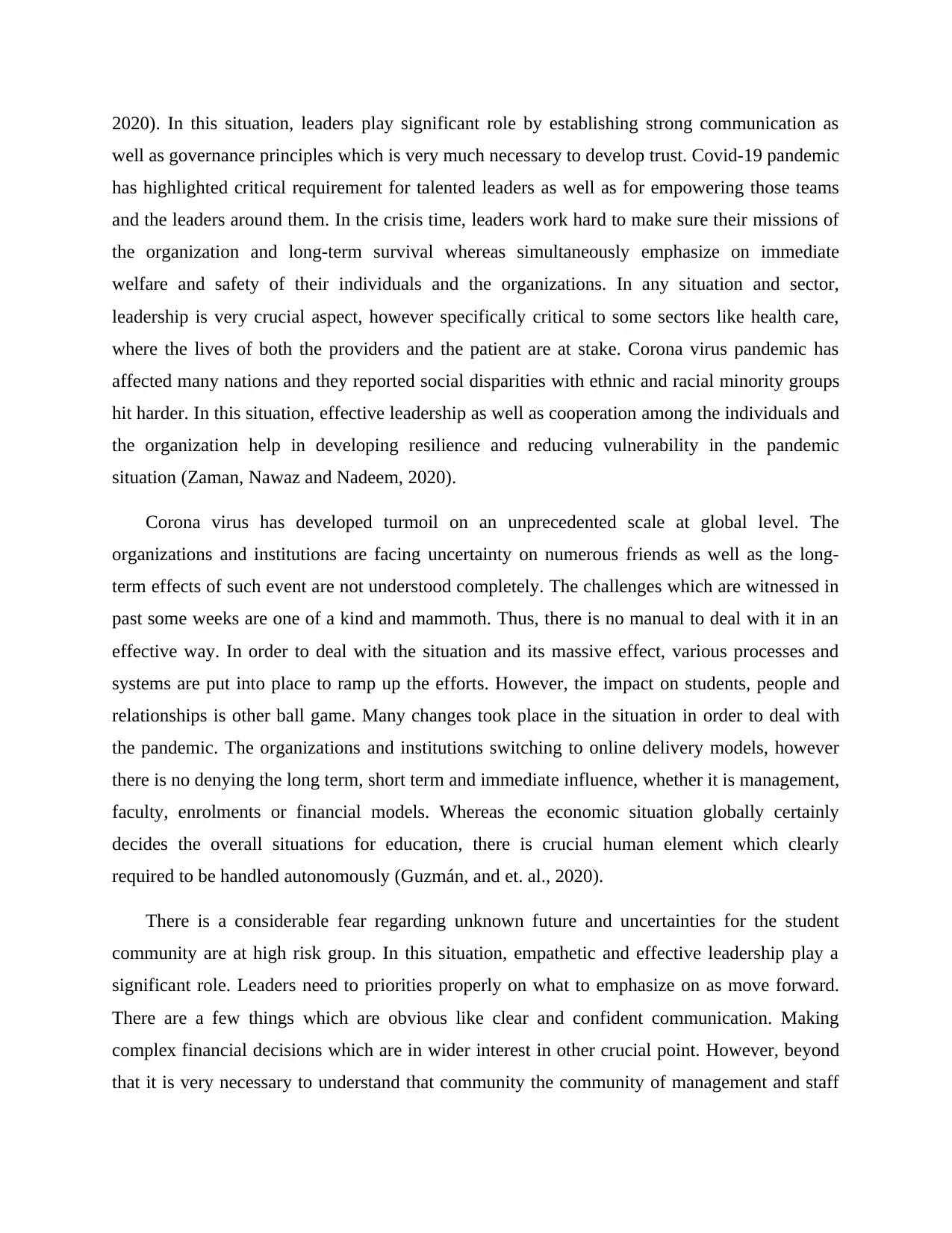
2020). In this situation, leaders play significant role by establishing strong communication as
well as governance principles which is very much necessary to develop trust. Covid-19 pandemic
has highlighted critical requirement for talented leaders as well as for empowering those teams
and the leaders around them. In the crisis time, leaders work hard to make sure their missions of
the organization and long-term survival whereas simultaneously emphasize on immediate
welfare and safety of their individuals and the organizations. In any situation and sector,
leadership is very crucial aspect, however specifically critical to some sectors like health care,
where the lives of both the providers and the patient are at stake. Corona virus pandemic has
affected many nations and they reported social disparities with ethnic and racial minority groups
hit harder. In this situation, effective leadership as well as cooperation among the individuals and
the organization help in developing resilience and reducing vulnerability in the pandemic
situation (Zaman, Nawaz and Nadeem, 2020).
Corona virus has developed turmoil on an unprecedented scale at global level. The
organizations and institutions are facing uncertainty on numerous friends as well as the long-
term effects of such event are not understood completely. The challenges which are witnessed in
past some weeks are one of a kind and mammoth. Thus, there is no manual to deal with it in an
effective way. In order to deal with the situation and its massive effect, various processes and
systems are put into place to ramp up the efforts. However, the impact on students, people and
relationships is other ball game. Many changes took place in the situation in order to deal with
the pandemic. The organizations and institutions switching to online delivery models, however
there is no denying the long term, short term and immediate influence, whether it is management,
faculty, enrolments or financial models. Whereas the economic situation globally certainly
decides the overall situations for education, there is crucial human element which clearly
required to be handled autonomously (Guzmán, and et. al., 2020).
There is a considerable fear regarding unknown future and uncertainties for the student
community are at high risk group. In this situation, empathetic and effective leadership play a
significant role. Leaders need to priorities properly on what to emphasize on as move forward.
There are a few things which are obvious like clear and confident communication. Making
complex financial decisions which are in wider interest in other crucial point. However, beyond
that it is very necessary to understand that community the community of management and staff
well as governance principles which is very much necessary to develop trust. Covid-19 pandemic
has highlighted critical requirement for talented leaders as well as for empowering those teams
and the leaders around them. In the crisis time, leaders work hard to make sure their missions of
the organization and long-term survival whereas simultaneously emphasize on immediate
welfare and safety of their individuals and the organizations. In any situation and sector,
leadership is very crucial aspect, however specifically critical to some sectors like health care,
where the lives of both the providers and the patient are at stake. Corona virus pandemic has
affected many nations and they reported social disparities with ethnic and racial minority groups
hit harder. In this situation, effective leadership as well as cooperation among the individuals and
the organization help in developing resilience and reducing vulnerability in the pandemic
situation (Zaman, Nawaz and Nadeem, 2020).
Corona virus has developed turmoil on an unprecedented scale at global level. The
organizations and institutions are facing uncertainty on numerous friends as well as the long-
term effects of such event are not understood completely. The challenges which are witnessed in
past some weeks are one of a kind and mammoth. Thus, there is no manual to deal with it in an
effective way. In order to deal with the situation and its massive effect, various processes and
systems are put into place to ramp up the efforts. However, the impact on students, people and
relationships is other ball game. Many changes took place in the situation in order to deal with
the pandemic. The organizations and institutions switching to online delivery models, however
there is no denying the long term, short term and immediate influence, whether it is management,
faculty, enrolments or financial models. Whereas the economic situation globally certainly
decides the overall situations for education, there is crucial human element which clearly
required to be handled autonomously (Guzmán, and et. al., 2020).
There is a considerable fear regarding unknown future and uncertainties for the student
community are at high risk group. In this situation, empathetic and effective leadership play a
significant role. Leaders need to priorities properly on what to emphasize on as move forward.
There are a few things which are obvious like clear and confident communication. Making
complex financial decisions which are in wider interest in other crucial point. However, beyond
that it is very necessary to understand that community the community of management and staff
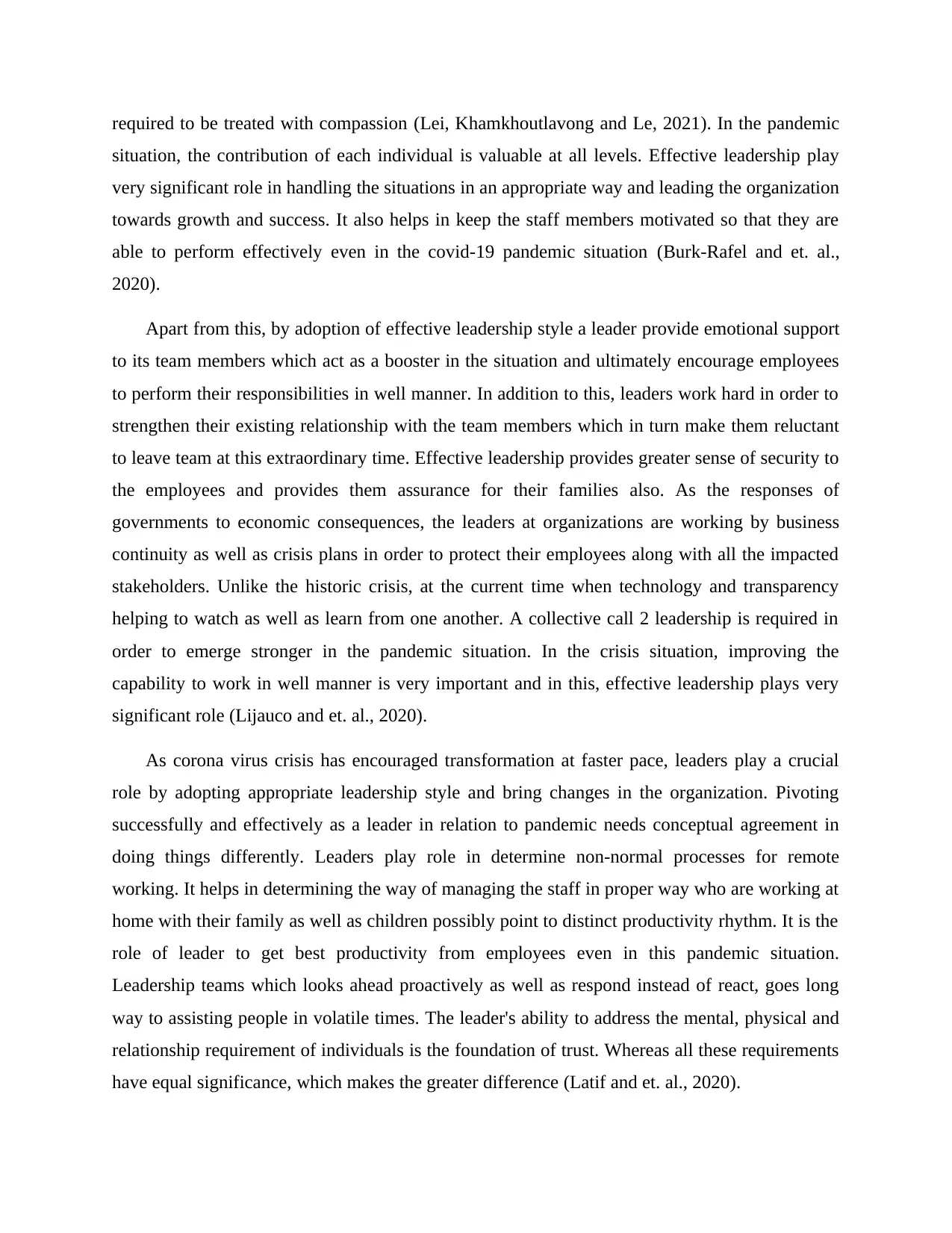
required to be treated with compassion (Lei, Khamkhoutlavong and Le, 2021). In the pandemic
situation, the contribution of each individual is valuable at all levels. Effective leadership play
very significant role in handling the situations in an appropriate way and leading the organization
towards growth and success. It also helps in keep the staff members motivated so that they are
able to perform effectively even in the covid-19 pandemic situation (Burk-Rafel and et. al.,
2020).
Apart from this, by adoption of effective leadership style a leader provide emotional support
to its team members which act as a booster in the situation and ultimately encourage employees
to perform their responsibilities in well manner. In addition to this, leaders work hard in order to
strengthen their existing relationship with the team members which in turn make them reluctant
to leave team at this extraordinary time. Effective leadership provides greater sense of security to
the employees and provides them assurance for their families also. As the responses of
governments to economic consequences, the leaders at organizations are working by business
continuity as well as crisis plans in order to protect their employees along with all the impacted
stakeholders. Unlike the historic crisis, at the current time when technology and transparency
helping to watch as well as learn from one another. A collective call 2 leadership is required in
order to emerge stronger in the pandemic situation. In the crisis situation, improving the
capability to work in well manner is very important and in this, effective leadership plays very
significant role (Lijauco and et. al., 2020).
As corona virus crisis has encouraged transformation at faster pace, leaders play a crucial
role by adopting appropriate leadership style and bring changes in the organization. Pivoting
successfully and effectively as a leader in relation to pandemic needs conceptual agreement in
doing things differently. Leaders play role in determine non-normal processes for remote
working. It helps in determining the way of managing the staff in proper way who are working at
home with their family as well as children possibly point to distinct productivity rhythm. It is the
role of leader to get best productivity from employees even in this pandemic situation.
Leadership teams which looks ahead proactively as well as respond instead of react, goes long
way to assisting people in volatile times. The leader's ability to address the mental, physical and
relationship requirement of individuals is the foundation of trust. Whereas all these requirements
have equal significance, which makes the greater difference (Latif and et. al., 2020).
situation, the contribution of each individual is valuable at all levels. Effective leadership play
very significant role in handling the situations in an appropriate way and leading the organization
towards growth and success. It also helps in keep the staff members motivated so that they are
able to perform effectively even in the covid-19 pandemic situation (Burk-Rafel and et. al.,
2020).
Apart from this, by adoption of effective leadership style a leader provide emotional support
to its team members which act as a booster in the situation and ultimately encourage employees
to perform their responsibilities in well manner. In addition to this, leaders work hard in order to
strengthen their existing relationship with the team members which in turn make them reluctant
to leave team at this extraordinary time. Effective leadership provides greater sense of security to
the employees and provides them assurance for their families also. As the responses of
governments to economic consequences, the leaders at organizations are working by business
continuity as well as crisis plans in order to protect their employees along with all the impacted
stakeholders. Unlike the historic crisis, at the current time when technology and transparency
helping to watch as well as learn from one another. A collective call 2 leadership is required in
order to emerge stronger in the pandemic situation. In the crisis situation, improving the
capability to work in well manner is very important and in this, effective leadership plays very
significant role (Lijauco and et. al., 2020).
As corona virus crisis has encouraged transformation at faster pace, leaders play a crucial
role by adopting appropriate leadership style and bring changes in the organization. Pivoting
successfully and effectively as a leader in relation to pandemic needs conceptual agreement in
doing things differently. Leaders play role in determine non-normal processes for remote
working. It helps in determining the way of managing the staff in proper way who are working at
home with their family as well as children possibly point to distinct productivity rhythm. It is the
role of leader to get best productivity from employees even in this pandemic situation.
Leadership teams which looks ahead proactively as well as respond instead of react, goes long
way to assisting people in volatile times. The leader's ability to address the mental, physical and
relationship requirement of individuals is the foundation of trust. Whereas all these requirements
have equal significance, which makes the greater difference (Latif and et. al., 2020).
⊘ This is a preview!⊘
Do you want full access?
Subscribe today to unlock all pages.

Trusted by 1+ million students worldwide
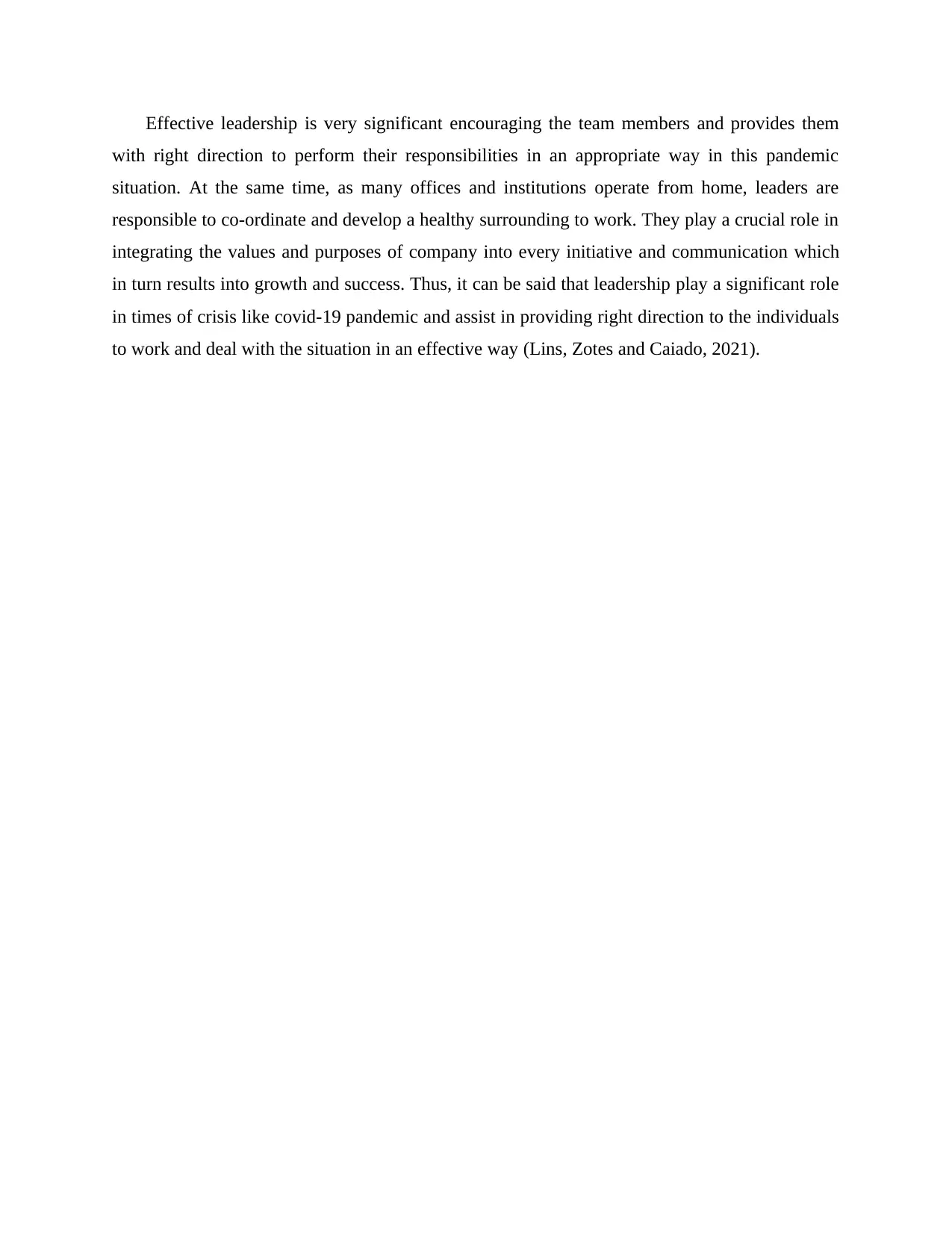
Effective leadership is very significant encouraging the team members and provides them
with right direction to perform their responsibilities in an appropriate way in this pandemic
situation. At the same time, as many offices and institutions operate from home, leaders are
responsible to co-ordinate and develop a healthy surrounding to work. They play a crucial role in
integrating the values and purposes of company into every initiative and communication which
in turn results into growth and success. Thus, it can be said that leadership play a significant role
in times of crisis like covid-19 pandemic and assist in providing right direction to the individuals
to work and deal with the situation in an effective way (Lins, Zotes and Caiado, 2021).
with right direction to perform their responsibilities in an appropriate way in this pandemic
situation. At the same time, as many offices and institutions operate from home, leaders are
responsible to co-ordinate and develop a healthy surrounding to work. They play a crucial role in
integrating the values and purposes of company into every initiative and communication which
in turn results into growth and success. Thus, it can be said that leadership play a significant role
in times of crisis like covid-19 pandemic and assist in providing right direction to the individuals
to work and deal with the situation in an effective way (Lins, Zotes and Caiado, 2021).
Paraphrase This Document
Need a fresh take? Get an instant paraphrase of this document with our AI Paraphraser
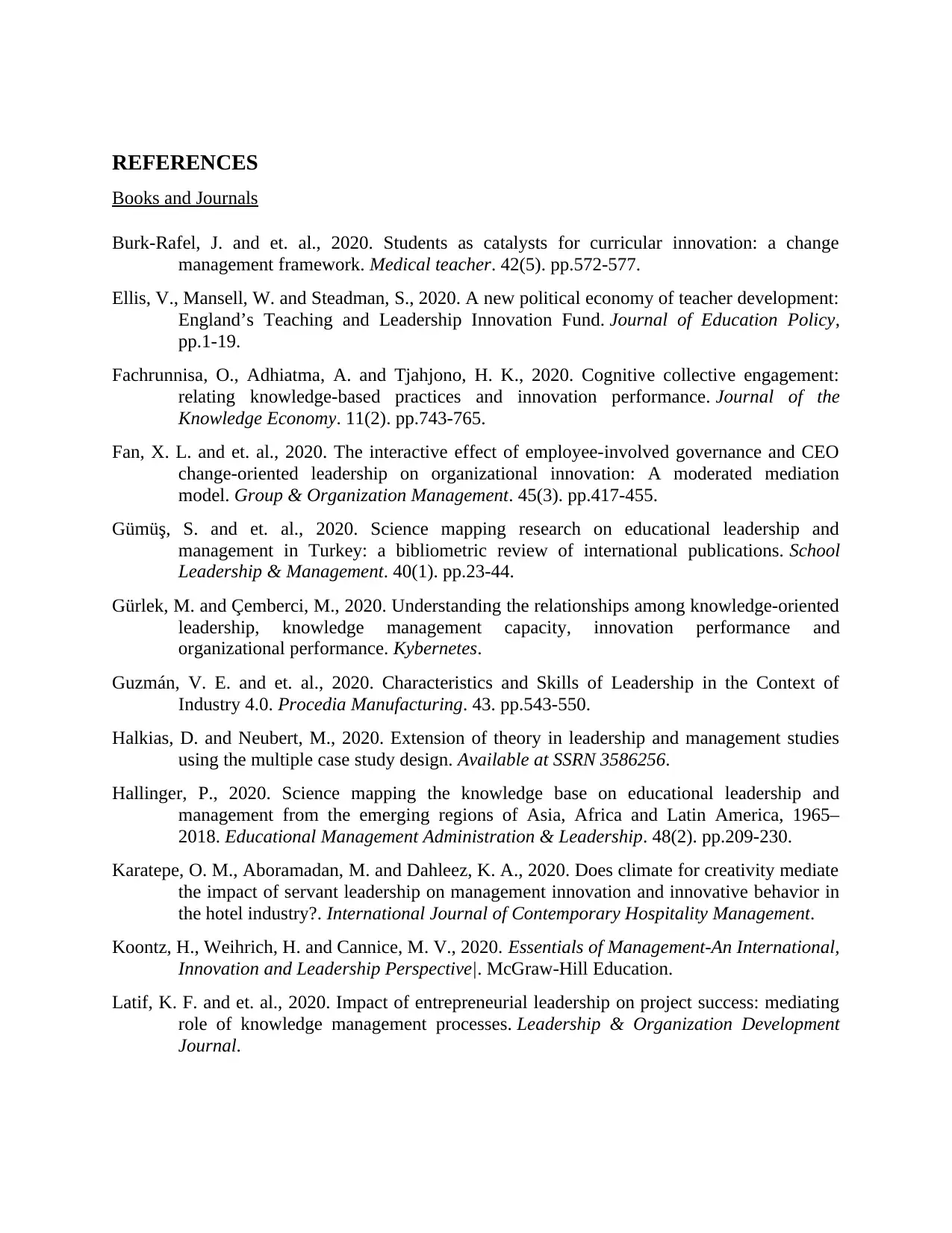
REFERENCES
Books and Journals
Burk-Rafel, J. and et. al., 2020. Students as catalysts for curricular innovation: a change
management framework. Medical teacher. 42(5). pp.572-577.
Ellis, V., Mansell, W. and Steadman, S., 2020. A new political economy of teacher development:
England’s Teaching and Leadership Innovation Fund. Journal of Education Policy,
pp.1-19.
Fachrunnisa, O., Adhiatma, A. and Tjahjono, H. K., 2020. Cognitive collective engagement:
relating knowledge-based practices and innovation performance. Journal of the
Knowledge Economy. 11(2). pp.743-765.
Fan, X. L. and et. al., 2020. The interactive effect of employee-involved governance and CEO
change-oriented leadership on organizational innovation: A moderated mediation
model. Group & Organization Management. 45(3). pp.417-455.
Gümüş, S. and et. al., 2020. Science mapping research on educational leadership and
management in Turkey: a bibliometric review of international publications. School
Leadership & Management. 40(1). pp.23-44.
Gürlek, M. and Çemberci, M., 2020. Understanding the relationships among knowledge-oriented
leadership, knowledge management capacity, innovation performance and
organizational performance. Kybernetes.
Guzmán, V. E. and et. al., 2020. Characteristics and Skills of Leadership in the Context of
Industry 4.0. Procedia Manufacturing. 43. pp.543-550.
Halkias, D. and Neubert, M., 2020. Extension of theory in leadership and management studies
using the multiple case study design. Available at SSRN 3586256.
Hallinger, P., 2020. Science mapping the knowledge base on educational leadership and
management from the emerging regions of Asia, Africa and Latin America, 1965–
2018. Educational Management Administration & Leadership. 48(2). pp.209-230.
Karatepe, O. M., Aboramadan, M. and Dahleez, K. A., 2020. Does climate for creativity mediate
the impact of servant leadership on management innovation and innovative behavior in
the hotel industry?. International Journal of Contemporary Hospitality Management.
Koontz, H., Weihrich, H. and Cannice, M. V., 2020. Essentials of Management-An International,
Innovation and Leadership Perspective|. McGraw-Hill Education.
Latif, K. F. and et. al., 2020. Impact of entrepreneurial leadership on project success: mediating
role of knowledge management processes. Leadership & Organization Development
Journal.
Books and Journals
Burk-Rafel, J. and et. al., 2020. Students as catalysts for curricular innovation: a change
management framework. Medical teacher. 42(5). pp.572-577.
Ellis, V., Mansell, W. and Steadman, S., 2020. A new political economy of teacher development:
England’s Teaching and Leadership Innovation Fund. Journal of Education Policy,
pp.1-19.
Fachrunnisa, O., Adhiatma, A. and Tjahjono, H. K., 2020. Cognitive collective engagement:
relating knowledge-based practices and innovation performance. Journal of the
Knowledge Economy. 11(2). pp.743-765.
Fan, X. L. and et. al., 2020. The interactive effect of employee-involved governance and CEO
change-oriented leadership on organizational innovation: A moderated mediation
model. Group & Organization Management. 45(3). pp.417-455.
Gümüş, S. and et. al., 2020. Science mapping research on educational leadership and
management in Turkey: a bibliometric review of international publications. School
Leadership & Management. 40(1). pp.23-44.
Gürlek, M. and Çemberci, M., 2020. Understanding the relationships among knowledge-oriented
leadership, knowledge management capacity, innovation performance and
organizational performance. Kybernetes.
Guzmán, V. E. and et. al., 2020. Characteristics and Skills of Leadership in the Context of
Industry 4.0. Procedia Manufacturing. 43. pp.543-550.
Halkias, D. and Neubert, M., 2020. Extension of theory in leadership and management studies
using the multiple case study design. Available at SSRN 3586256.
Hallinger, P., 2020. Science mapping the knowledge base on educational leadership and
management from the emerging regions of Asia, Africa and Latin America, 1965–
2018. Educational Management Administration & Leadership. 48(2). pp.209-230.
Karatepe, O. M., Aboramadan, M. and Dahleez, K. A., 2020. Does climate for creativity mediate
the impact of servant leadership on management innovation and innovative behavior in
the hotel industry?. International Journal of Contemporary Hospitality Management.
Koontz, H., Weihrich, H. and Cannice, M. V., 2020. Essentials of Management-An International,
Innovation and Leadership Perspective|. McGraw-Hill Education.
Latif, K. F. and et. al., 2020. Impact of entrepreneurial leadership on project success: mediating
role of knowledge management processes. Leadership & Organization Development
Journal.
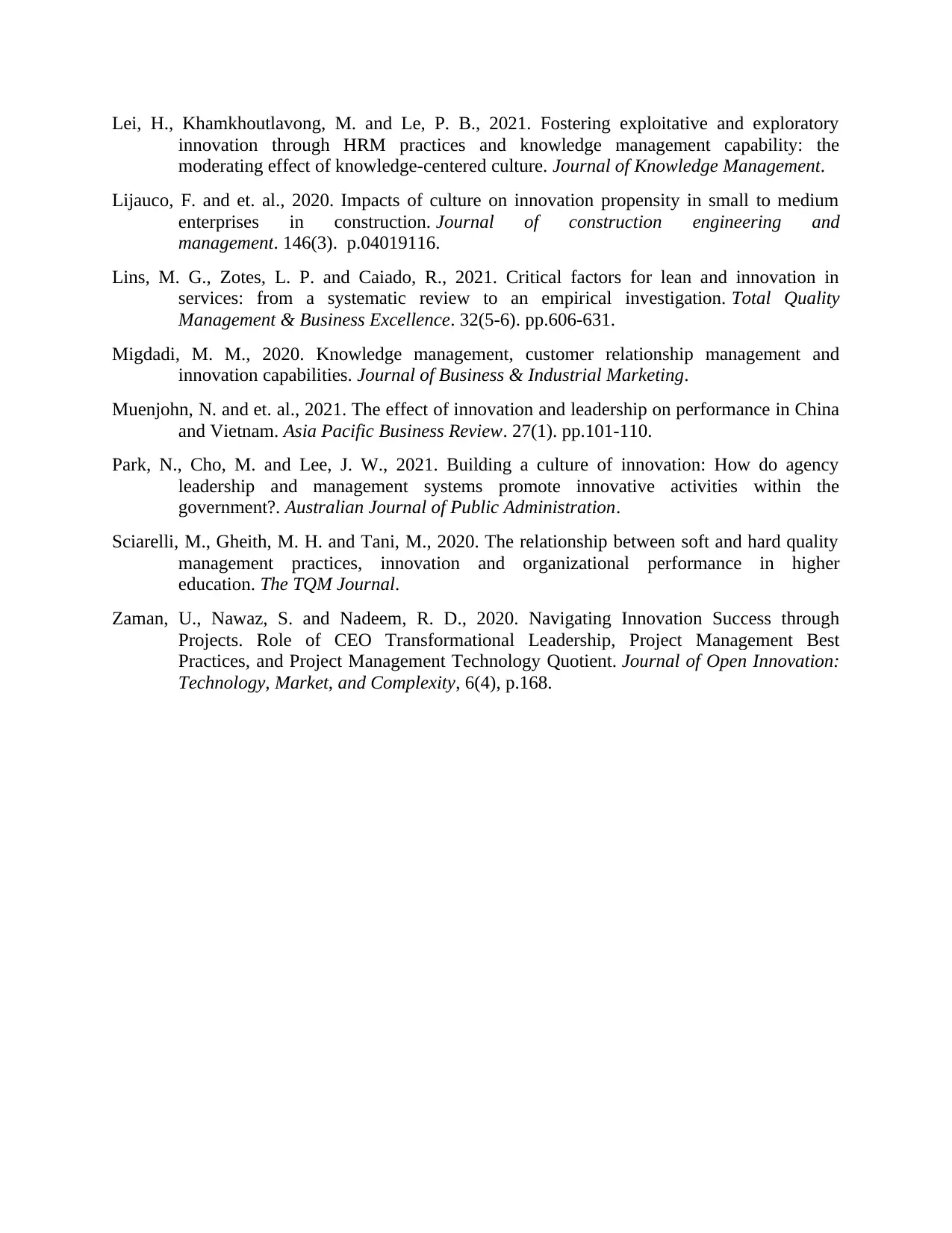
Lei, H., Khamkhoutlavong, M. and Le, P. B., 2021. Fostering exploitative and exploratory
innovation through HRM practices and knowledge management capability: the
moderating effect of knowledge-centered culture. Journal of Knowledge Management.
Lijauco, F. and et. al., 2020. Impacts of culture on innovation propensity in small to medium
enterprises in construction. Journal of construction engineering and
management. 146(3). p.04019116.
Lins, M. G., Zotes, L. P. and Caiado, R., 2021. Critical factors for lean and innovation in
services: from a systematic review to an empirical investigation. Total Quality
Management & Business Excellence. 32(5-6). pp.606-631.
Migdadi, M. M., 2020. Knowledge management, customer relationship management and
innovation capabilities. Journal of Business & Industrial Marketing.
Muenjohn, N. and et. al., 2021. The effect of innovation and leadership on performance in China
and Vietnam. Asia Pacific Business Review. 27(1). pp.101-110.
Park, N., Cho, M. and Lee, J. W., 2021. Building a culture of innovation: How do agency
leadership and management systems promote innovative activities within the
government?. Australian Journal of Public Administration.
Sciarelli, M., Gheith, M. H. and Tani, M., 2020. The relationship between soft and hard quality
management practices, innovation and organizational performance in higher
education. The TQM Journal.
Zaman, U., Nawaz, S. and Nadeem, R. D., 2020. Navigating Innovation Success through
Projects. Role of CEO Transformational Leadership, Project Management Best
Practices, and Project Management Technology Quotient. Journal of Open Innovation:
Technology, Market, and Complexity, 6(4), p.168.
innovation through HRM practices and knowledge management capability: the
moderating effect of knowledge-centered culture. Journal of Knowledge Management.
Lijauco, F. and et. al., 2020. Impacts of culture on innovation propensity in small to medium
enterprises in construction. Journal of construction engineering and
management. 146(3). p.04019116.
Lins, M. G., Zotes, L. P. and Caiado, R., 2021. Critical factors for lean and innovation in
services: from a systematic review to an empirical investigation. Total Quality
Management & Business Excellence. 32(5-6). pp.606-631.
Migdadi, M. M., 2020. Knowledge management, customer relationship management and
innovation capabilities. Journal of Business & Industrial Marketing.
Muenjohn, N. and et. al., 2021. The effect of innovation and leadership on performance in China
and Vietnam. Asia Pacific Business Review. 27(1). pp.101-110.
Park, N., Cho, M. and Lee, J. W., 2021. Building a culture of innovation: How do agency
leadership and management systems promote innovative activities within the
government?. Australian Journal of Public Administration.
Sciarelli, M., Gheith, M. H. and Tani, M., 2020. The relationship between soft and hard quality
management practices, innovation and organizational performance in higher
education. The TQM Journal.
Zaman, U., Nawaz, S. and Nadeem, R. D., 2020. Navigating Innovation Success through
Projects. Role of CEO Transformational Leadership, Project Management Best
Practices, and Project Management Technology Quotient. Journal of Open Innovation:
Technology, Market, and Complexity, 6(4), p.168.
⊘ This is a preview!⊘
Do you want full access?
Subscribe today to unlock all pages.

Trusted by 1+ million students worldwide
1 out of 12
Related Documents
Your All-in-One AI-Powered Toolkit for Academic Success.
+13062052269
info@desklib.com
Available 24*7 on WhatsApp / Email
![[object Object]](/_next/static/media/star-bottom.7253800d.svg)
Unlock your academic potential
Copyright © 2020–2025 A2Z Services. All Rights Reserved. Developed and managed by ZUCOL.





